
Aaron Ross (Predictable Revenue) and Jason Lemkin (SaaStr) have helped companies like Salesforce.com and EchoSign achieve record-breaking growth. In their new book, From Impossible to Inevitable, they team up to share their systematic approach that has led to their repeated successes. Ross and Lemkin have proven that taking a company from nothing to hyper-growth requires much more than a great product. It requires dedication to all levels of the business, and the ability to systematize a growth mindset in your company.
In From Impossible To Inevitable, they show how you can grow your company through developing repeatable processes that will consistently drive revenue and increase your growth. But they also show the painful truths that entrepreneurs, salespeople, and marketers have been holding onto for too long and are keeping them from reaching their full potential.
Here are 3 of those painful truths for sales and marketers, and how Ross and Lemkin suggest you can get over them to take your company to the next level and “kick off your biggest growth spurt yet.”
Key Lessons: From Impossible to Inevitable
Painful Truth 1: “Build it and they will come” is a fairy tale
You can have an awesome product, but no one will find out about it if you don’t have a lead generation pipeline. This is the takeaway from Create Predictable Pipeline, the second section of From Impossible To Inevitable.
That predictability comes not only from developing specific sales and marketing processes, but also predictable customer success processes, as most of your customer’s lifetime value comes after the initial sale.
Customer success should be at the heart of your business strategy. Ross and Lemkin see the head of customer success as being on par with the heads of marketing and sales, and just as important to achieving this predictable pipeline. By putting customer success at the core of your company, you’re “targeting, creating product for, and servicing, the kinds of customers that need your product.”
Customer Success As A Revenue Driver
Through this mindset, customer success moves away from being “glorified customer support” and becomes a true revenue driver. By investing in customer success you can:
- Lower your churn—Keeping your current customers successful means they will stay, and stay paying.
- Increase revenue—Those customers will refer others, and also be more amenable to newer products and upgrading.
- Improve your marketing—Customer success gives you testimonials to use on your site, showing potential customers coming through other lead generation efforts just how much companies like them appreciate your product .
#1 on that list, lowering churn, is about the best thing you can do if you want to have stellar growth and really boost your revenue. Every customer you lose is not only lost revenue from that person/company, but also the additional money you have to spend to replace them. Lowering churn increases customer lifetime value (LTV) and decreases customer acquisition costs (CAC). Achieving the fabled 3:1 LTV:CAC ratio required for huge growth is only possible if you get your churn to rock bottom. And we mean rock bottom.
Retention with Different Levels of Churn
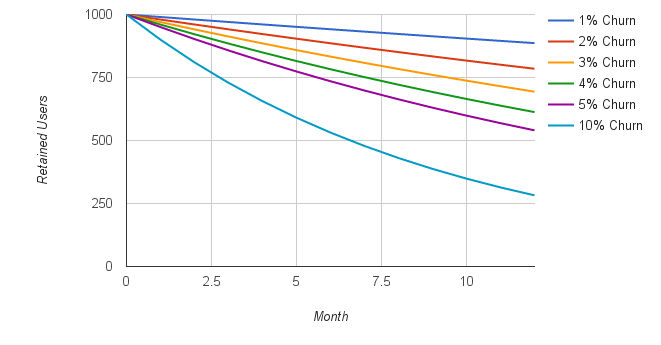
A monthly churn level of 3% is generally considered good within the SaaS industry. But all that churn adds up to losing almost a third of your original customers within a year. Those are all customers that you have to replace just to break even, without even considering growth.
And that’s good churn. With a churn level of 5% per month, something that SaaS companies can see from time to time, you’ve lost half your customers. With 10% churn, 3 out of every 4 of your original customers will have to be replaced by the end of the year.
Good churn is actually negative. Though you can’t get negative customer churn, you can get negative revenue churn. This is where you not only keep your customers, but they upgrade, spending more by the end of the period than at the beginning.
Account Value by Cohort at 5% Negative Churn
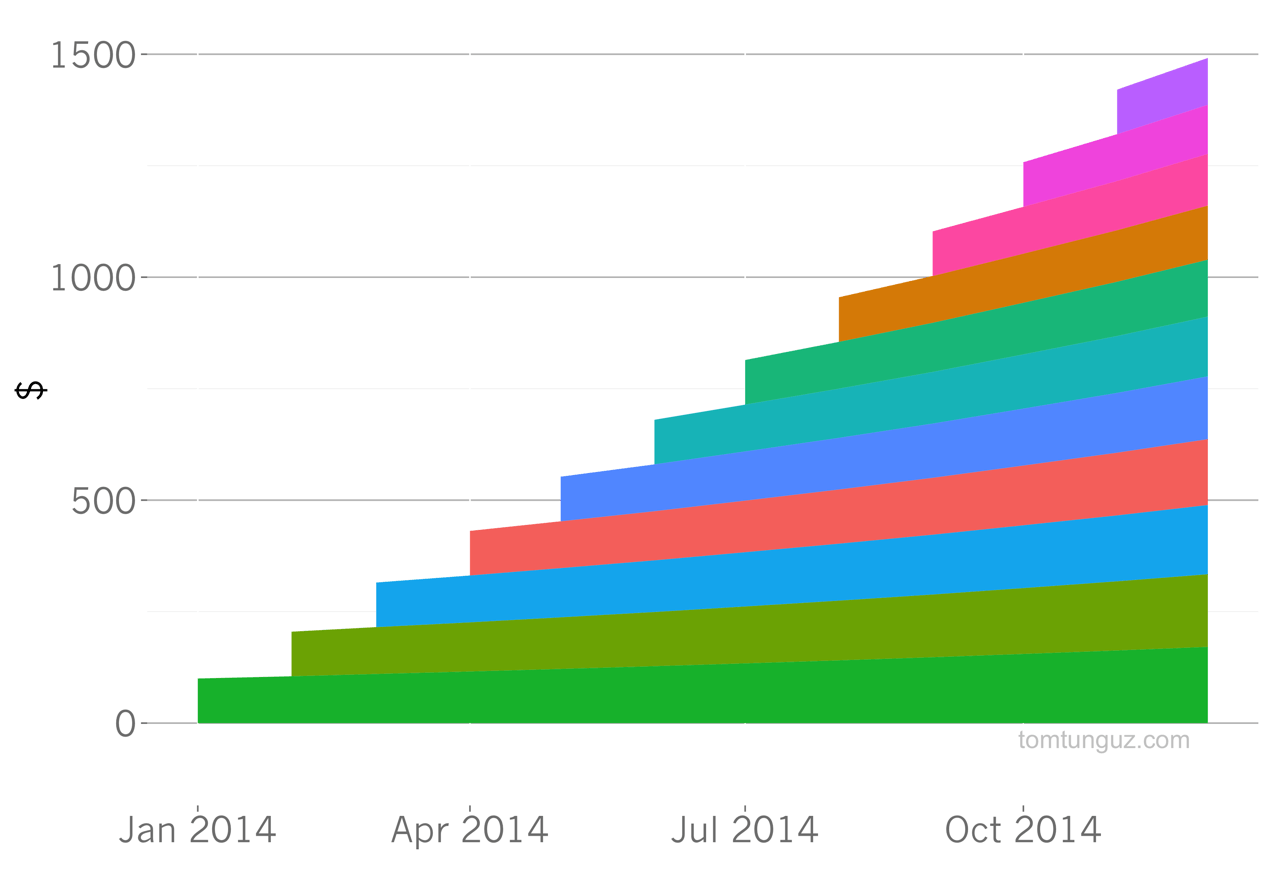
Tom Tunguz shows what this can look like when you start negatively churning cohorts on top of each other. Each cohort grows over time as the customers in it upsell and cross-sell. These layer on top of each other, increasing the foundation for each new cohort and increasing your revenue from both new and current customers.
Ross and Lemkin point out that by investing in customer success you can significantly lower churn, setting that solid foundation for the rest of your team, company, and revenue to grow.
From The Book: Brad Warga On Dropping Churn
Brad Warga is the VP of Sales at Gild, a company that helps others recruit engineers more effectively. He lays out the 3 methods Gild uses to drop churn to rock bottom:
- 90-day adoption: As soon as the customer signs up, the customer success team at Gild goes to work. They train the new users on how to use the product, best practices for recruiting engineers, and keep the excitement levels high through these first few uses.
- Quarterly business reviews: By getting together, onsite, with customers every quarter, the customer success team can continually make sure that the customer is getting the most out of the product, and using it as intended.
- Predictive tools: Using both external (Zendesk, Olark) tools and internal dashboards, the customer success team can spot at-risk customers whose usage is dropping and contact them to iron out issues. They can also use this data to see who is maximizing their use of Gild and should be contacted by a sales rep for possible upgrade.
The takeaway from Gild is that people who understand the core value of your product are the ones that retain. Show that to them early, and you’ll not only reduce your churn, you’ll also have a customer who is going to tell everyone else about how awesome you are, want more, and spend more.
Painful Truth 2: Growth exposes your weaknesses
From Impossible To Inevitable is all about scaling, and one of the core focus points of Make Sales Scalable, the third section of the book, is how to scale your team so that you are always hiring the right people for the job at the right time.
At each stage—from small, to medium, to large, to huge—having the right people to execute the right strategy is critical. This goes double for sales. Get the wrong VP Sales at the wrong time and your growth can quickly stall, and you’ll have trouble regaining any early momentum you picked up.
If your VP Sales is your weak point, then that will have a serious detrimental effect on your company. It’s hard to deal with, but you will have to make the decision to move that person on and get the right salesperson in to do the job.
The Right VP Sales At The Right Time
Ross and Lemkin lay out the 4 types of VP Sales needed for critical junctures in your growth. Each of these will make a crucial impact on your company, but only if they’re hired at the right time:
The Right Sales VP
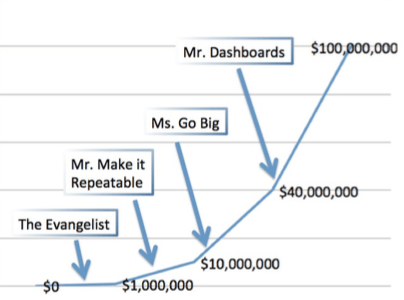
The Evangelist: $0-$1M
This is what most people think about when they envision a VP of Sales. Someone who is all passion for the project and the product. For early stage startups, an evangelist can seem like the answer to their prayers.
The problem is that they often have trouble moving beyond this stage. As they have always made their sales through their enthusiasm and personality, they have no idea how to scale and systematize sales. They’re good for those first few big deals, but just when you need to a put a process in place, they can’t help.
What’s more, an early stage startup should already have an evangelist-type salesperson—the CEO. You should be your evangelist, and only hire a VP of Sales when you’re ready to put a system in place and need some experience.
Mr. Make it Repeatable: $1M-$10M
This is the guy who takes your sales strategy and turns it into a constant pipeline of leads, prospects, and deals. It is a crucial hire in these early stages as it’s the person who is laying the foundation for continual growth. It’s also the hardest hire to make.
This is because not a lot of people have the right experience to make this predictable pipeline happen. You’ll be looking to hire someone away from a big company with the promise of a flashy new title and a sweet compensation package. But the salespeople at billion-dollar companies don’t necessarily have the skills to build a company.
But it’s imperative you make this hire. As Ross and Lemkin say, “Everything seems much simpler and clearer. Almost immediately, revenue goes up. Because they know how to close, recruit, hire and coach. And they know how to build the basic processes you need to make it predictable.”
Ms. Go Big: $10M-$40M
This position is all about taking the process and super-sizing it. They increase hires, start specializations within the team and work with the VP Marketing to grow the inbound and outbound marketing and sales. They want to make a machine that produces revenue.
Ross and Lemkin say the best place to look for these VPs is companies that have just gone through this stage and have crushed it themselves. If they know how to keep the sales machine turning, you want them now.
Mr. Dashboards: $40M+
This is the final, but not necessarily inevitable, hire. Ross and Lemkin say you might need this guy once you are “past Unstoppable,” but that he is a liability before that, not knowing how to really scale and get to that $40M point in the first place.
He is going to refine your process, picking out all the way you can make marginal gains in an already successful team, but his skills lie in managing managers rather than growing revenue himself.
Leadership is what’s important, and different leadership is vital at different stages. Don’t be won over by great resumes alone. Just because someone has worked at a unicorn, doesn’t mean they got that unicorn to grow. Look for exactly what you need at each stage of your growth and hire due to those requirements. Get it wrong and you’ll stall, but get it right and you’re on track to hyper-growth.
From The Book: Mark Roberge On Sales Recruiting
Roberge is HubSpot’s Chief Revenue Officer and grew the sales team at HubSpot from $0 to $100M. He has hired hundreds of sales reps and interviewed thousands. He lays out what he sees as the 5 indicators of future success for hiring anyone in your sales team:
- Coachability. This is always #1. If they can’t learn your way of doing things, then they aren’t going to make any significant difference to the company.
- Prior Success. This doesn’t have to come from sales. If someone has excelled in any area of life, that can show that they have the determination to succeed in business. A great example of this type of hiring thinking at HubSpot is Colleen Coyne, an inbound marketing consultant. Yes, she had previous experience at Groove Networks and Microsoft, but what really stood out was that she is a gold medal-winning olympian.
- Work Ethic. Sales is a lot of rejection. Therefore, anyone that’s going to excel needs the ability to keep going even in the tough times. They also need the work ethic that will get them on calls, emails, and visits all day long.
- Curiosity. The people that are really going to get the great sales are the ones that want to know exactly what potential customers need. They are going to go that extra mile to find out, always asking why.
- Intelligence. This should go without saying. You’re not hiring for a boiler room. You need intelligent salespeople who can ask the right questions and get the right answers for their customers.
Painful Truth 3: It’s hard to build a big business out of small deals
If you’re selling your product for $10 per month, $100M ARR is a long, long way away. It’s possible, and some of the most well-known companies achieve high growth selling a low-priced tool, but there is a quicker, easier way to get to $100M: instead of selling companies your product for $10, sell them your solution for $100K.
This is the advice in the Double Your Dealsize section of From Impossible To Inevitable. Ross and Lemkin have nothing against low-priced products, and point out that every company starts with small customers and that they’ll continue to be a not-insignificant part of revenue for even large companies for years.
Finding The Right Deal Size For Your Company
Using EchoSign as an example, they show that there is a common split of revenue for most SaaS companies in their early years.
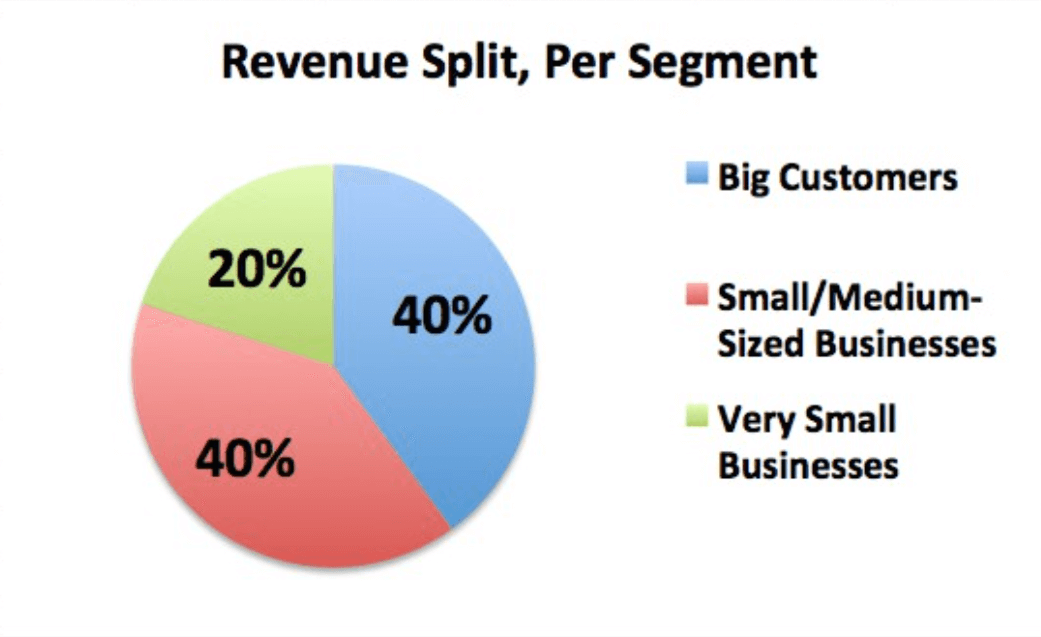
40% of revenue comes from big customers, 40% from SMBs, and 20% from very small businesses. But once you get to $1M ARR, you are going to have to choose one of them as your number one priority. A diverse pool of customers and revenue is good, but one sector has to take precedent.
And that sector should be those big customers. If you can solve a big problem for them, they will pay, and pay big.
If you look at what upping revenue per customer can do, you’ll see why. Increasing revenue per customer means you need to acquire fewer customers:
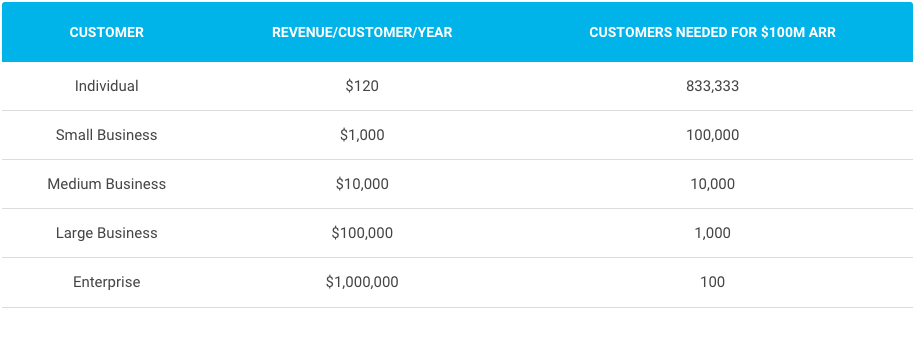
Fewer customers means that you can concentrate your resources on the customers that are really willing to pay for them, making yourself more efficient.
You have to offer these customers a solution rather than just a tool. Again, looking at EchoSign, their tool, a way to sign documents digitally, was worth $15 per month to users. But a solution for companies on how they could manage, sign, and distribute thousands of documents? That was worth $1,000,000.
If you are offering just a tool to companies, it is incredibly difficult for your contacts within that company to get buy-in from key stakeholders. They can’t see how a tool is worth $10K, let alone $100K. But if you can offer an entire solution to these companies, solving their problem with support, marketing, or payroll, that is worth that $100K to the C-suite, and solves a burning pain for an enterprise company, and they will pay.
By going upmarket, you can increase your deal size while decreasing the number of deals needed to grow. Of course, you’ll still want diverse streams of revenue, so you don’t want to ignore or remove SMB customers, but having the framework in place to service and provide a solution to enterprise customers will mean big deal after big deal.
This means more people, more infrastructure, more security, and more cost. But this is the type of investment that is crucial to boosting growth and going from an SMB yourself to massive company.
From the Book: Mark Cranney On Going After Enterprise
Mark Cranney, partner at Andreessen Horowitz, points out 3 things about going upmarket that most entrepreneurs and startups will never have dealt with before:
- Dealing with internal processes: “You have to learn how to go after and sell to companies who are hundreds or thousands of employees. And it’s a new skill. Decision-making in large organizations is a long, tortuous process due to legacy technology deployments, internal politics, entrenched home-grown solutions, sunk cost of integrations, account control by incumbent vendors, and the sheer size and scale involved.”
- Salespeople create new value for customers: “At Opsware, sales reps would come back to me and say, ‘Look, there’s no budget for data center automation at XYZ company.’And I’d say, ‘of course there was no budget for data center automation back then: the market hadn’t been established yet.’ Our job was to go out there and show customers a different and better way of doing business.”
- It only starts when you’ve landed the big deal: “It’s precisely when the product seems to be selling itself that building out this sales team and process is critical: Stopping or stalling at that point could expose the company to the competition and lose the race to be #1 in its category.”
All You Need To Achieve Hyper-Growth
There’s plenty more to learn from this book on all parts of building a successful company. Whether you’re wondering how to hire right for your sales positions, how to get out of a rut in Year 5, or how to inspire ownership among your team, Ross and Lemkin have advice from their extensive experience, as well as from other entrepreneurs and investors.
Ross and Lemkin reiterate that it all comes down to building a process. Don’t expect any quick wins, hacks, or viral hits on your pathway to success. What’s really important is putting the systems in place to get the right people, build the right product, generate the right leads, and get the right customers. From there, hyper-growth goes From Impossible To Inevitable.
Join thousands of business professionals reading the Mattermark Daily newsletter. A daily digest of timely, must-read posts by investors and operators.
This is a guest post by Brian Whalley of Klaviyo, which helps stores make their customers happier while also growing sales through email marketing.